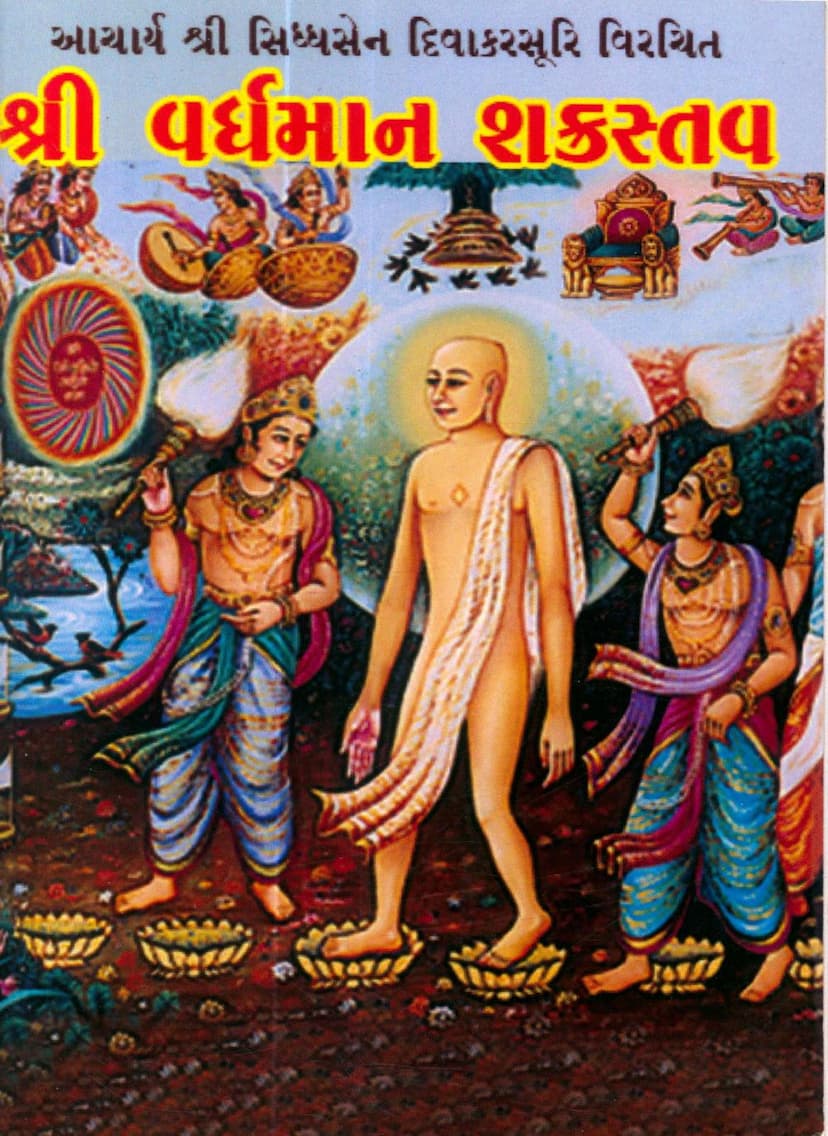Vardhaman Shakrastav
Added to library: September 2, 2025

Summary
Here's a comprehensive summary of the Jain text "Vardhaman Shakrastav" by Mahodaysagarsuri, based on the provided pages:
Title: Shri Vardhaman Shakrastav (A Hymn of Praise to Lord Mahavir)
Author: Acharya Shri Siddhsen Divakar Suri Ji Maharaj
Commentary/Translation: Acharya Bh. Shri Mahodayasagarsuri Ji Maharaj (disciple of Acharya Bh. Shri Gunadagarsuri Ji Maharaj)
Publisher: Mahodaysagarsuri Ji Maharaj (as per the catalog link, though the text itself mentions Shri Bhadresh Hirachand Cheda as the supporter and publisher).
Core Theme and Purpose: The "Shri Vardhaman Shakrastav" is a devotional hymn composed by the esteemed Jain scholar Acharya Siddhsen Divakar Suri. It is a powerful composition dedicated to praising the virtues and glory of Lord Mahavir (Vardhaman), the 24th Tirthankar. The text aims to elevate the reader's devotion, provide spiritual merit, and ultimately lead to liberation (moksha).
Key Content and Structure:
- Praise for Lord Mahavir: The central focus of the Shakrastav is the glorification of Lord Mahavir through a series of 273 epithets or attributes. These attributes describe his divine qualities, his role as a spiritual guide, his victory over inner enemies (kashayas), and his attainment of supreme knowledge and liberation.
- Sanskrit Text with Gujarati Commentary: The text is presented in Sanskrit (the original stotra), followed by a Gujarati translation and commentary. This allows readers to understand the profound meaning behind the Sanskrit verses.
- The Origin of the Stotra: The preface mentions that Acharya Siddhsen Divakar Suri received this stotra through the grace of Indra, who was pleased with his profound scholarship and devotion. The final verse of the stotra also alludes to this divine reception.
- Significance of the Epithets: The preface highlights the immense joy and spiritual upliftment experienced by Acharya Mahodayasagar Suri upon encountering these 273 epithets. He emphasizes that reading and contemplating these divine descriptions is more fulfilling than earthly pleasures.
- Mantra-Infused and Powerful: The stotra is described as being "mantra-garbhit" (infused with mantras) and containing "saghan arth" (dense meaning), making it highly potent for spiritual practice.
- Benefits of Recitation: The text outlines numerous benefits derived from the regular recitation and contemplation of the Shakrastav. These include:
- Spiritual Progress: Leading towards the ultimate goal of liberation (moksha).
- Material Prosperity: An incidental benefit is the attainment of various material advantages and positive outcomes in life, as indicated by the "chulikao" (supplementary verses) within the stotra.
- Inner Peace and Bliss: Experiencing unparalleled joy and spiritual contentment.
- Purification of Speech: Sanctifying one's tongue through praising the Lord.
- Overcoming Obstacles: Removing sins, defects, and obstacles in life.
- Attaining Virtues: Cultivating divine qualities and virtues.
- Divine Grace: Earning the favor of gods and benevolent beings.
- Positive Influence on the Environment: Making the elements (earth, water, fire, air, space) favorable.
- Winning Hearts: Gaining the affection and favor of good people.
- Manifestation of Desires: Fulfilling virtuous wishes.
- Guidance on Practice: The text provides practical advice for practicing the stotra:
- Learning: It is recommended to learn the stotra from a Guru with correct pronunciation.
- Regular Recitation: Daily recitation is encouraged, ideally thrice daily, or at least once in the morning.
- Understanding the Meaning: Reciting with an understanding of the meaning is emphasized for deeper connection.
- Devotional Attitude: The recitation should be performed with faith and devotion in a place of worship or at home before the image of the Lord.
- Emphasis on Moksha as the Ultimate Goal: While acknowledging the material benefits, the preface strongly cautions against getting attached to them. The true aim of the devotion should be the ultimate liberation (moksha). Material gains are merely milestones, not the final destination.
- The Nature of Devotion: The text distinguishes between the name of God (which provides introduction) and the Namaskar mantra (which leads to complete surrender). It states that by cultivating love for God's name, one progresses to higher states of devotion and eventually attains a state beyond emotion.
- Specific Epithets and their Meanings: The bulk of the text consists of the Sanskrit verses with Gujarati explanations, enumerating the 273 divine attributes of Lord Mahavir. These describe him as:
- The Supreme Being, the source of all knowledge and power.
- One who has conquered all impurities and afflictions.
- Radiant like the sun.
- The dispeller of all sorrows.
- The one worshipped by gods and celestial beings.
- The destroyer of the cycle of birth and death.
- The embodiment of infinite virtues.
- The source of liberation and salvation.
- The guide and savior of humanity.
- And many more such sublime descriptions.
- Concluding Sections: The text concludes with the affirmation of the stotra's potency and the benefits of its practice, summarizing its role in spiritual development and well-being. It also includes verses of general praise and dedication to the Guru.
In essence, the "Vardhaman Shakrastav" is a profound devotional work within Jainism, offering a comprehensive list of Lord Mahavir's divine attributes. Its recitation is believed to purify the devotee, bring about spiritual and material well-being, and ultimately pave the path to liberation, when practiced with sincerity and the right intention.